
By Peggy Taylor
“No matter who you are, you are welcome here. No matter who you are, you will find something in our programming that resonates with you,” said Katherine Farley, Chair of the Board of Lincoln Center, at last Saturday’s high noon ribbon cutting for the reopening of David Geffen Hall, the home of the New York Philharmonic. Joined by the philanthropists, architects, engineers, and government officials who made the Hall’s rebirth possible, she reiterated the watchword now seen on the Hall’s bus-shelter billboards — “The New York Philharmonic: A New Home. For Everyone.”
Farley sent a special message of inclusion to Black and Hispanic New Yorkers, whose ancestors were driven from the Upper West Side when their neighborhood, San Juan Hill, was razed in the 1950’s so that Lincoln Center might rise. The Center, once viewed as aloof from the surrounding neighborhoods, is now reaching out to those neighborhoods and acknowledging a more inclusive vision of the past.
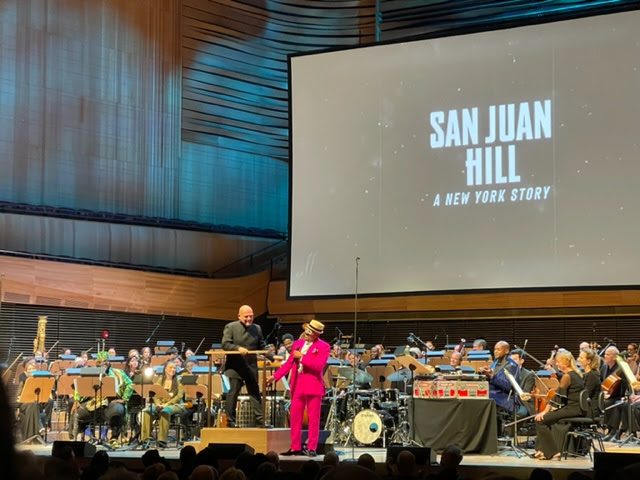
For the opening’s inaugural musical work, Lincoln Center tapped Trinidadian trumpeter, pianist, percussionist, and professor Etienne Charles, who composed “San Juan Hill: A New York Story,” featuring his Creole Soul Jazz Band and the Philharmonic. The work was accompanied by fascinating archival documents and visuals, the most memorable of which were photos of the streets of San Juan Hill superimposed on the same streets surrounding Lincoln Center today.
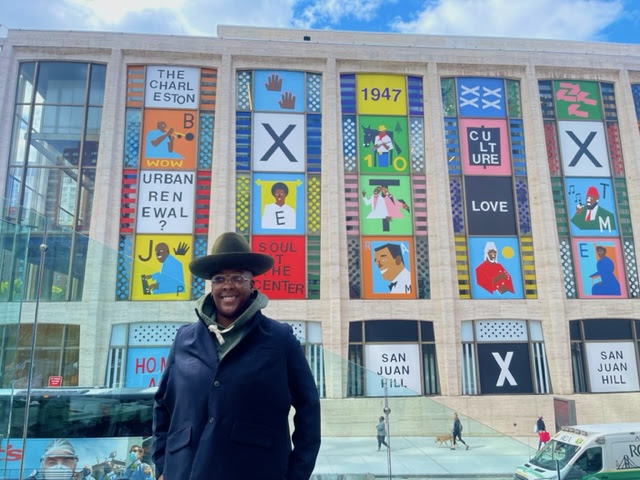
For art works, both inside and outside the new Hall, Lincoln Center turned to two of New York’s most original and powerful voices in contemporary art. For the exterior, they engaged 40-year-old African-American Nina Chanel Abney, whose 68-foot-high, 150-foot-long, site-specific “San Juan Heal,” enlivens the Hall’s northern facade with 35 colorful panels, and pays homage to the community with faces, words, and symbols.
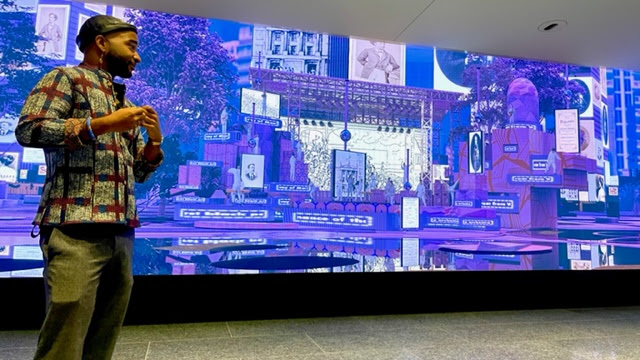
For the Hall’s lobby, the Center engaged 36-year-old African-American Artist Jacolby Satterwhite, who produced an astonishing, Jerome Bosch-inspired video, “An Eclectic Dance to the Music of Time,” on the lobby’s new 50′-wide digital screen. Dazzling the viewer with rich, complex, fantastical 3D animation and sculptures, the video runs continually when the wall isn’t live-streaming the Philharmonic’s concerts for free.
The goal of outreach and welcome is evident in every aspect of the new Hall.
The lobby, which the box office once dominated and whose floor was tiled, is now partially carpeted and dubbed “The Living Room,” where concertgoers can sink into multi-colored sofas and enjoy a pre-concert cup of coffee or cocktail. Bars flank the lobby, and a cafe is planned for the west end with outdoor dining, weather permitting.

No stone was left unturned to transform the auditorium into a more intimate and welcoming setting. The number of seats was reduced by 200 (2500 instead of 2700) thus enhancing the acoustics and enveloping concertgoers in clear, beautiful sound. (Poor acoustics plagued the Hall’s previous iterations for years.)
The stage, once stationary, is now movable and, thanks to 20 supporting elevators, can advance 25 feet into the audience, bringing musicians closer to the public, thus creating a greater feeling of intimacy. The stage can retract and contract to host a diverse array of events—pop concerts, movie premiers, chamber music ensembles, and theatrical performances. Eclecticism at its best. Something for everyone.
The proscenium, which once separated the musicians from the audience, has been removed. The shape of the Hall is now “in-the-round,” with the public sitting behind the orchestra in the choir loft when the choir isn’t performing. The floor’s rake has been deepened so that those with orchestra seats have a better view of the stage. Higher platforms on the stage allow the musicians to better view and hear each other. And then there are the warm colors of the fabric used for the seats—red, orange, yellow, and pink rose petals falling against a background of deep blue. As Interior Designer Billie Tsien of Tod Williams Billie Tsien Architects said, “I’m tired of beige.”
Even the title on the Philharmonic’s programs expresses the Hall’s new vision. Rather than “The New David Geffen Hall,” it reads: “Your New David Geffen Hall,” or “My New David Geffen Hall.”
The Philharmonic continued its outreach recently with a private concert honoring the 1,000 plus workers who took part in the $550 million renovation, which was completed on time and on budget. The Hall will host two celebratory galas on October 26 and October 28 and a free Open House on October 29 and an Open House Family Sunday, October 30. More evidence of offering something for everyone.
All these acts of inclusion and welcoming add up to what Matthew Lella of Diamond Schmitt Architects calls “an embrace.” And who doesn’t need an embrace these days?
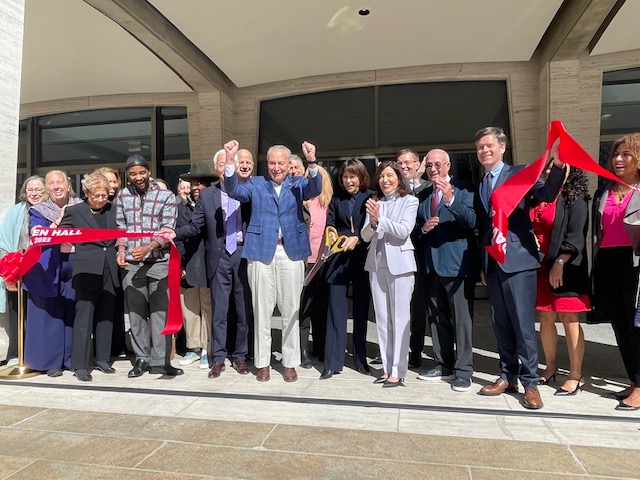
At the ribbon cutting, U.S. Senator Majority Leader Chuck Schumer predicted that the new Hall will be “a huge shot in the arm for New York’s cultural scene, for Lincoln Center, for the economy, and for the spirit and morale of our city.” The pandemic, he recalled, was so difficult for New Yorkers because we were “not able to gather to share meaningful experiences like live concerts. Our cultural institutions are the lifeblood of this city. People want to be together. We want to mix and mingle and celebrate our enormous diversity.”
Time will tell whether David Geffen Hall will succeed in its goals of welcome and outreach, but given the joyful crowds who attended Saturday’s matinee and night performances and who mingled and lingered long afterwards, the new David Geffen Hall, Our New David Geffen Hall, is off to a brilliant start.
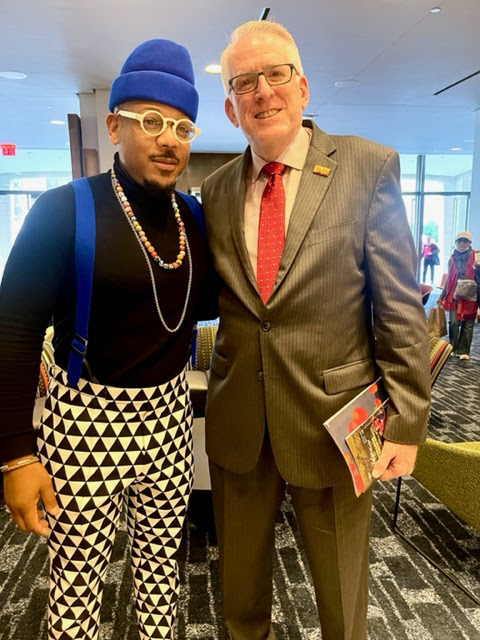










Looks terrific, but just hope they finally broke the sound barrier after spending a half a billion dollars.
This looks like an incredible renovation. I am excited to plan a visit!
We’re going Thursday, we will then have seen (and heard) all three configurations. Looking forward to it.
This is very exciting – I’ll be there tomorrow night!
Is it still David Geffen Hall? Wasn’t that what they called it *last* year?
It’s the “New David Geffen Hall” in the sense that it was seriously renovated. It has indeed been David Geffen Hall since 2014, when they changed the name from Avery Fisher Hall.
Still Geffen for now, but we’re all eagerly awaiting to find out what next year’s name for the hall will be!
Those chairs!?!? Ugh.
I will never forget the Klinghoffer opera.
According to most news sources, the seating capacity was reduced by 500 down to 2,200 from former 2,700.
You are correct. I erred. My apologies.
Congratulations on righting a.wrong committed 60 years ago. The result is magnificent. There was no mention of Steven Spielberg’s remake of “West Side Story” that helped put the spotlight on the sad story of the thriving neighborhood that was home to a diversity of cultures and productivity obliterated by “Urban Renewal and prejudice.
Thank you for making a public show of the
diversity and brilliance of our fabulous city.
If you just go a few blocks south plenty of the tenements that had been where Lincoln Center is now – they are there and there is still that diversity that was a hallmark of the UWS for quite some time.
And I sould add this. Homes were razed and people were forced to move from an amazing neighborhood At the same time, when this happened the UWS was not wealthy. Without Lincoln Center’s creation, would gentrification have occurred? And without homes being destroyed, could Lincoln Center have beeb built? And yes. Poor homes were destroyed to make Lincoln Center. The group least able to stay in the neighborhood.
All that being said, this part of the article makes not much sense, ”
Black and Hispanic New Yorkers, whose ancestors were driven from the Upper West Side when their neighborhood, San Juan Hill,” Shouldn’t this be an apology to the poor of NYC in general? Last I checked it was black people, Irish, Italian, Latino, and Hispanic people, all driven out . Perhaps if it hadn’t been disproportionately Hispanic or latino, it wouldn’t have happened. But the fact is, poor Italians AND poor Puerto Rican’s had to leave. And wild guess but some of the poor families that have stayed in the tenements near Lincoln Center, their children won’t ve able to afford to stay.
I’m excited to hear some concerts this season, and I’m all for the inclusivity and welcoming embrace, as well as (above all) any acoustic improvements. But wow — from my strolls by recently, the lobby looks like a cross between an airport lounge, Multiplex movie theater, and midrange hotel room. The seats in the house (judging from various virtual tours) are exceedingly ugly: in toto, they appear like blown up images of pathology samples, or the aftermath of a paint explosion. They also look like movie theater seats. I’m sure I’ll be happily surprised by the experience once I attend a concert or two (provided no one’s damn cell phone goes off!).
I was there on Sat. For the San Juan hill legacy and it was fabulous, we were on first tier and the sound was magnificent..I am certainly not an acoustics specialist I just know what I hear.. I will b back for more!,!
Thank you, Peggy, for this wonderful article.
After visiting with my 97yr old longtime Upper West Side friend, Theo Dixon, I met another one of my mother’s friends, Ron Solomon, at My Geffen Hall last evening. Wow!!! The experience being surrounded by such a beautiful, well-functioning performance space was just spectacular! It felt so modern in every way!